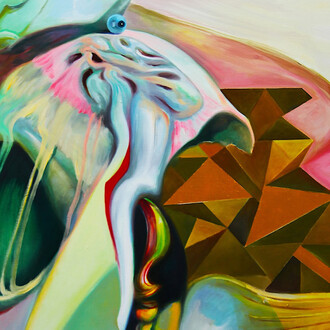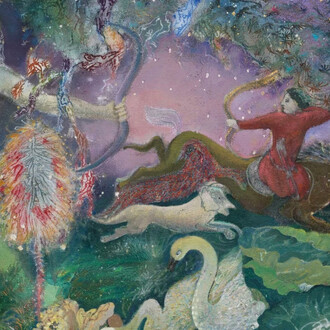Thomas McDonell sculpts paintings. Applying urethane alkyd enamel – a heavy-duty industrial house paint – with his hands, McDonell focuses his attention on a collision of raw materials, allowing for confident, impulsive gestures. Eschewing brushes, oils and acrylics, the Figueroa St. paintings seem purely expressive: there is no preamble, no wind-up, the painting is its own palette, the site of the original idea. The suggestion of a handprint, of fingernails scratching thickly applied paint evoke the notion that a painting is something to be grappled with, wrestled or coaxed into place.
The work deals with gesture, form, and temporality. Large smears, splashes and swipes of color within non-representational compositions form complex interlocked arrangements and atmospheres. Using historically fundamental substrates such as canvas and linen, and donated mistint house paint for its surplus -- the paintings have formal concerns having to do with composition and color, marks and depth, and the evidence of process.
Within marks and color, surprising textures mingle and overlap, dodging interpretation but also tempting the viewer the eye yearns to define and simplify the murky and abstract, but a figure or a shape is another attachment, like a name or title. McDonell prefers the anonymous, using only shorthand signifiers to identify the paintings, allowing them to float in and out of one another. In this way they play with ideas of individualism and personal versus collective identity. They are boundless, and the contradictions that they present free them from the limitations of categorization as abstraction, which they are not.
McDonell cites conversations with Desmond Morris, ethologist and author of The biology of art, as the catalyst to his finger painting, which began as a way to reduce mediation in the work. Morris analyzes the art making practices and behaviors of primates, and contrasts them with a socio-historical framework of human art and aesthetics. One apt example is his examination of a finding by Rhoda Kellogg (early childhood psychologist, scholar, and archivist of children's artwork) that young apes and children will scribble and draw — with hands or tools — when shown what to do, yet human children quickly begin to imitate while apes do not; Morris goes on to cite Scottish painter Alan Davies, who, when teaching art, began his classes with "pure idea-less activity," drumming into his students the notion that "work without thought requires a great deal of mental discipline [...] before he can achieve an image without the intermediacy of reasoning".
Are these paintings cynical? McDonell encourages the question. The works are an investigation into the creative process and its origins. McDonell’s practice now extends beyond canvas and paint: wooden frames are milled in LA and assembled in his studio, a process he likens to putting a period at the end of a phrase. Ceramic sculptures shine with dark, inky glazes and earthy silica. Their spiral ridges and horizontal grooves are marked by deeper calligraphic scratches, mirroring and counterpointing the hand markings of the paintings.The pedestals that support the ceramics are made of great rolls and stacks of newspaper, as if a vase perched atop is a wellhead gathering together nodes of time and information. News, text, media — current and outdated, faded — is piled together under a simple clay pot holding fresh-cut flowers: the present. Temporality underpins the work, but McDonell’s impulse is to create worlds without necessarily adhering to a historical timeline.The Japanese philosopher Soetsu Yanagi, founder of early 20th century mingei movement, celebrates beauty in everyday, utilitarian objects created by unknown craftsmen. The Figueroa St. works propose the paintings as an esoteric practice, and an exercise of the soul. Ancient art — painting caves, carving bones, etching stones — once served a practical, evolutionary purpose. Morris writes, “it might even be argued that the modern human artist has little more reason for painting a picture than does a chimpanzee....” Exploring a spiritual artist but the work should say "I am.” McDonell “didn't need these paintings to have an object or goal,” he wanted “them to be themselves.” One recent painting has an anomalously poetical title, “untitled (mystic dharma).” Near McDonell’s studio on Figueroa St. once glowed a giant temple, orange like a Tibetan monk’s robes, against a cloudless blue sky.
Originally the Fourth Church of Christ, the building was constructed in 1924, a time when Christian Science was at its height of membership. Mystic Dharma Buddhist Temple was founded to serve the area’s Mandarin Chinese community and moved into the church in the early 1980s. It had stained glass windows and a large indoor worship or meditation room: a good room for painting. But the Buddhists are gone now, the temple is a christian church again. There are some celebrity members and the pastor is a budding influencer. The building has been blasted white. It’s set to open this September, too.
This ties into an economy of form: art-by-limitation, art made with available resources via the donated house paint, the discarded newspapers. Zooming out, the passage of time sees large-scale conurbation, the conversion of old storefronts into high rises, and the liminal and pragmatic energy of the Mystic Dharma temple: constantly shapeshifting to house a different faith, a different practice. These paintings live in and document that moment of transition.
















